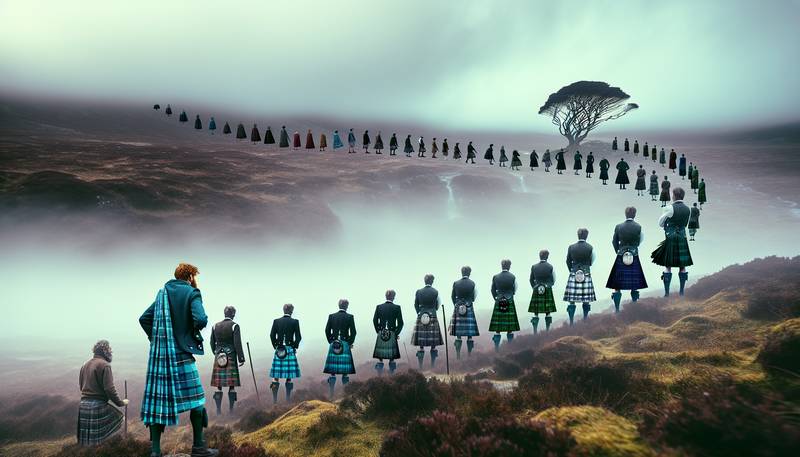Swinging Kilts: Scottish Highland Dress Through the Ages

A Brief History of the KiltWith origins as mysterious as a foggy Scottish moor, the kilt has evolved from a simple length of cloth to a symbol of national pride and identity. In the beginning, Scottish Highlanders wore the belted plaid, a long piece of fabric that was pleated and wrapped around the waist, with the excess draped across one shoulder. This early version of the kilt was called the "breacan an fhéilidh" or "great kilt."The great kilt was both utilitarian and versatile – it could be worn as a cloak, a blanket, or even a makeshift tent. However, the true transformation of the kilt occurred in the 18th century when an enterprising Englishman named Thomas Rawlinson decided to make kilts fashionable again. He introduced the "small kilt" or "walking kilt," which was essentially the lower half of the great kilt without the excess fabric.Despite their long history, kilts have not always been beloved by the Scottish people. In 1746, after the Battle of Culloden, the British government banned the wearing of kilts in an attempt to suppress Highland culture. Thankfully, the ban was lifted in 1782, and kilts slowly regained their place in the hearts of the Scots.Understanding Tartan PatternsJust as important as the kilt itself is the tartan pattern, which represents various clans and families throughout Scotland. Tartan is a pattern of horizontal and vertical stripes, or "sett," that combines various colors. The arrangement of colors and stripes can be incredibly complex and is fiercely protected by the Scottish Tartans Authority.It's worth noting that not all tartans are associated with specific clans. There are "district" tartans, which represent a particular region of Scotland, and "universal" tartans, which can be worn by anyone regardless of their ancestry. Some modern tartans have even been created to represent organizations, events, or causes – such as the "Robertson Hunting" tartan, which was designed for the International Association of Crazy Golfers.Accessorizing Your KiltNo true Scotsman would be caught dead in just a kilt. The traditional Highland Dress is a complex ensemble of accessories, each with its own history and significance. Here are some essential items to complete your kilt outfit:- Sporran: This small pouch, typically made of leather or fur, hangs from a chain or belt around the waist. The sporran serves as a functional pocket, since kilts do not have pockets themselves. Sporrans can range from simple and practical designs to ornate and decorative pieces featuring Celtic knots and symbols.
- Kilt hose: These knee-high socks, usually white or off-white, are typically made from wool and feature a decorative "cuff" at the top. A proper kilt hose should be folded down once, just below the knee, with the top edge resting on the bottom edge of the kneecap.
- Ghillie brogues: Traditional Scottish shoes, characterized by long laces that wrap around the ankle and tie in front. Ghillie brogues are often worn without socks, but can also be paired with kilt hose for a more formal look.
- Sgian-dubh: A small, single-edged knife that is traditionally kept tucked into the top of the kilt hose. The sgian-dubh (pronounced "skean-doo") is often highly decorated, with a carved handle and intricate sheath. In fact, many modern sgian-dubhs are purely ornamental and do not have a functional blade.
- Kilt pin: A decorative pin, usually featuring a clan crest or symbol, that is attached to the front apron of the kilt. The kilt pin adds a touch of style to the outfit and can also help keep the apron in place on windy days.
How to Wear a Kilt with ConfidenceNow that you have your kilt and accessories, it's time to learn how to wear them with pride. First, ensure that your kilt is the proper length – it should fall to the middle of your kneecap when you're standing straight. The pleats should be at the back, with the flat "apron" in the front. Your sporran should hang about a hand's width below your navel and should be centered on your body.When it comes to the debate of what to wear under a kilt, opinions vary. Some traditionalists insist on going "regimental," or commando, while others prefer the modesty and comfort of underwear. Ultimately, what you choose to wear (or not wear) under your kilt is a personal decision – just be prepared for curious inquiries and the occasional gust of wind.Finally, remember that confidence is key when wearing a kilt. As with any bold fashion choice, you'll likely attract attention and questions from onlookers. Embrace your inner Highlander and wear your kilt with pride, knowing that you're representing centuries of tradition and culture.So, Swing Your Kilt with Pride!Whether you're attending a Highland Games event, a ceilidh (traditional Scottish gathering), or simply going for a stroll in the countryside, wearing a kilt is a unique and stylish way to embrace your Scottish heritage. Just remember to swing your kilt with confidence, and perhaps invest in a sturdy kilt pin for those blustery days!
|
|








